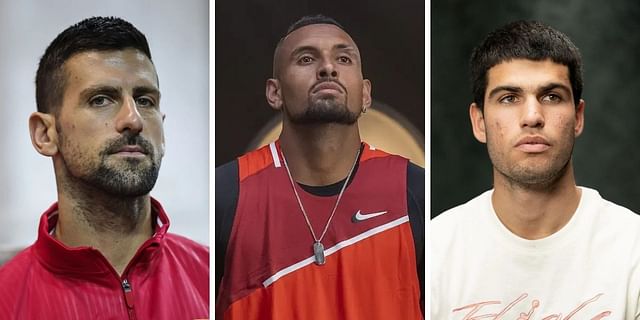
Nick Kyrgios has never been one to shy away from sharing his bold and often unconventional views on the state of professional tennis. His latest proposition involves a radical shake-up of the Grand Slam format for men’s matches, advocating for a shift from the traditional best-of-five sets to best-of-three up until the quarterfinal stage. According to the Australian star, this adjustment would address scheduling issues and provide new opportunities for lower-ranked players, while adding a fresh layer of unpredictability to early-round matches.
In his recent appearance on *The AO Show* podcast on November 18, Kyrgios, who has been on an extended hiatus from competitive tennis due to injury and is set to make his comeback in 2025, elaborated on his idea. “I would make Grand Slams best of three [sets] up until the quarterfinals,” the 29-year-old remarked, expressing his frustration with the current scheduling challenges posed by best-of-five matches in the early stages of Grand Slam tournaments. “You know, the first week’s scheduling gets out of control with both the men’s side and the women’s side playing best of five, and sometimes the women’s matches go long, best of three. I mean, men’s matches finishing till 2-3 AM, it’s just not sustainable.”
To illustrate his point, Kyrgios cited instances of marathon matches that have disrupted schedules and extended into the early hours. One notable example was the 2024 Australian Open second-round match between Daniil Medvedev and Emil Ruusuvuori, which ended at 3:39 AM local time after starting at 11:16 PM. Such grueling encounters, Kyrgios suggested, are becoming increasingly common and, in his view, undermine both player well-being and fan engagement.
Kyrgios’ proposal does not call for a total elimination of the best-of-five format at Grand Slams; rather, he believes it should be preserved for the later rounds. “I think if you made it best of three until the quarterfinals, you’d see some guys break through to the quarterfinals. Obviously, then the better players would end up winning best of five anyway. So I think a best of three until the quarterfinals and from then on, best of five. That’s what I would immediately change at a Grand Slam,” he elaborated. By reducing match lengths in the early rounds, Kyrgios hopes to create more opportunities for surprise upsets and potential breakthroughs by lesser-known players.
In supporting his argument, Kyrgios pointed to how the established stars of the sport often recover from losing the first set in a best-of-five format, reducing the suspense of early-round contests. He specifically highlighted the case of his compatriot Li Tu’s match against Carlos Alcaraz at the 2024 US Open. Tu managed to win a set against the Spanish star but ultimately fell as Alcaraz clinched three sets out of four. “How many times have we seen one of the best players in the draw lose the first set and you’re just like, ‘He’s going to come back and win it.’ It’s actually boring,” Kyrgios argued. “Where like if Novak [Djokovic] goes down a set or even when Li Tu, he won a set against Alcaraz early on, that was one set all and then it’s one set, that could change Li’s entire career. He beats Alcaraz on center court and you become a name.”
Kyrgios believes this potential for shock results and underdog victories would inject new life into the men’s game, bringing a level of unpredictability often associated with the women’s side of the sport. He previously touched on this theme during the 2024 US Open, using Aryna Sabalenka’s swift quarterfinal victory over Zheng Qinwen as a striking contrast to an epic first-round men’s match between Dan Evans and Karen Khachanov. While Sabalenka’s win took just over an hour, Evans and Khachanov battled for nearly six hours. Kyrgios expressed his thoughts on social media platform X (formerly Twitter): “This match will go for just over an hour. Quarterfinals. Evans/Khachanov went 5 hours and 45 mins. First round. Maybe we do best of three for the men up until the quarters? Then best of five? But this is kinda crazy.”
In Kyrgios’ view, reducing early-round matches to best-of-three sets would not only streamline tournament scheduling but also present additional hurdles for dominant figures like Djokovic and Alcaraz. The prospect of needing to quickly find their footing in shorter-format matches, without the luxury of a slow start, could make every round more unpredictable.
Kyrgios’ suggestion is not without its detractors. Traditionalists argue that the best-of-five format is an integral part of what makes Grand Slams unique, testing not only skill but also endurance and mental resilience. They point to the historical significance and dramatic narratives that have emerged from long, grueling matches. However, Kyrgios counters that evolving the sport is necessary to maintain its appeal to modern audiences and ensure players’ well-being.
While opinions on Kyrgios’ idea vary, his willingness to challenge norms and advocate for change reflects his passion for the sport. As he gears up for his competitive return, beginning with the World Tennis League exhibition event in December and then the 2025 Brisbane International, it remains to be seen whether his bold vision will gain traction among fans and tennis’ governing bodies. Regardless, Kyrgios’ call for a reimagined Grand Slam format underscores his desire to make the game more accessible, exciting, and, in his words, “less predictable.” Whether or not the sport follows his lead, the discussion he has sparked adds another layer of intrigue to tennis’ ongoing evolution.
Leave a Reply